2022 |
||
| 25. | 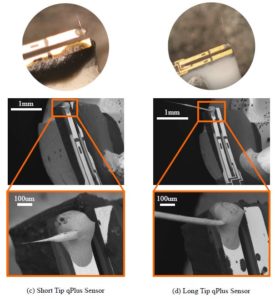 | M. G. Ruppert; D. Martin-Jimenez; Y. K. Yong; A. Ihle; A. Schirmeisen; A. J. Fleming; D. Ebeling Experimental Analysis of Tip Vibrations at Higher Eigenmodes of QPlus Sensors for Atomic Force Microscopy Journal Article In: Nanotechnology, vol. 33, iss. 18, pp. 185503, 2022, ISSN: 1361-6528, (This work was supported in part by the Australian Research Council Discovery Project DP170101813). Abstract | Links | BibTeX | Tags: Actuator, AFM, Cantilever, DP170101813, Multifrequency AFM, piezoelectric @article{Ruppert2022,QPlus sensors are non-contact atomic force microscope probes constructed from a quartz tuning fork and a tungsten wire with an electrochemically etched tip. These probes are self-sensing and offer an atomic-scale spatial resolution. Therefore, qPlus sensors are routinely used to visualize the chemical structure of adsorbed organic molecules via the so-called bond imaging technique. This is achieved by functionalizing the AFM tip with a single CO molecule and exciting the sensor at the first vertical cantilever resonance mode. Recent work using higher-order resonance modes has also resolved the chemical structure of single organic molecules. However, in these experiments, the image contrast can differ significantly from the conventional bond imaging contrast, which was suspected to be caused by unknown vibrations of the tip. This work investigates the source of these artefacts by using a combination of mechanical simulation and laser vibrometry to characterize a range of sensors with different tip wire geometries. The results show that increased tip mass and length cause increased torsional rotation of the tuning fork beam due to the off-center mounting of the tip wire, and increased flexural vibration of the tip. These undesirable motions cause lateral deflection of the probe tip as it approaches the sample, which is rationalized to be the cause of the different image contrast. The results also provide a guide for future probe development to reduce these issues. |
2020 |
||
| 24. | 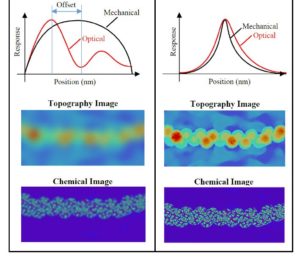 | A. J. Fleming; M. G. Ruppert; B. S. Routley; L. McCourt Overcoming the Limitations of Tip Enhanced Raman Spectroscopy with Intermittent Contact AFM Conference 8th Multifrequency AFM Conference, Madrid, Spain, 2020. Abstract | BibTeX | Tags: AFM, Multifrequency AFM, Optics, SPM @conference{Fleming2020,Tip enhanced Raman spectroscopy (TERS) is a promising technique for mapping the chemical composition of surfaces with molecular scale. However, current TERS methods are limited by a number of issues including high tip-sample forces, high laser power, low topographical resolution, and short probe lifetime. As a result, TERS methods are best suited to robust samples that can tolerate high optical intensity. To overcome these issues and extend the application of TERS to delicate samples, a number of new probes andimaging modes are in development at the University of Newcastle. This talk will provide an overview of these methods and present preliminary results, including new methods for optical probe optimization and fabrication, and a new dynamic-mode AFM method to reduce contact forces and applied laser power. |
| 23. | 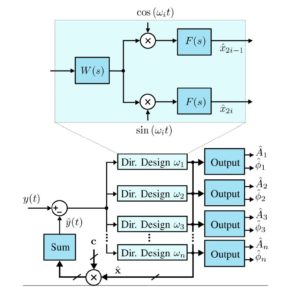 | M. G. Ruppert; D. M. Harcombe; A. J. Fleming Traditional and Novel Demodulators for Multifrequency Atomic Force Microscopy Conference 8th Multifrequency AFM Conference, Madrid, Spain, 2020. Abstract | BibTeX | Tags: AFM, Demodulation, Multifrequency AFM @conference{Ruppert2020b,A number of multifrequency atomic force microscopy (MF-AFM) methods make use of the excitation and detection of higher harmonics of the fundamental frequency, higher flexural eigenmodes or intermodulation products generated by the non-linear tip-sample force [1]. Schematically, these methods are depicted in Figure 1(a) where the main difference is the resulting spacing and amplitude of the frequency components in the generated spectrum shown in Figure 1(b). Regardless of which particular MF-AFM method is employed, each requires a demodulator to obtain amplitude and phase to form observables for the characterization of nanomechanical sample information. Since high-speed non-synchronous demodulators such as the peak-hold method, peak detector and RMS-to-DC converter are incompatible with MF-AFM [2], there is a need for high-bandwidth demodulation techniques capable of estimating multiple frequencies at once while maintaining robustness against unwanted frequency components [3]. In this talk, the performance of traditional and recently proposed demodulators for multifrequency atomic force microscopy is assessed experimentally. The compared methods include the lock-in amplifier, coherent demodulator, Kalman filter, Lyapunov filter, and direct-design demodulator. Each method is implemented on a field-programmable gate array (FPGA) with a sampling rate of 1.5 MHz. The metrics for comparison include implementation complexity, the sensitivity to other frequency components and the magnitude of demodulation artifacts for a range of demodulator bandwidths. Performance differences are demonstrated through higher harmonic atomic force microscopy imaging. |
| 22. | 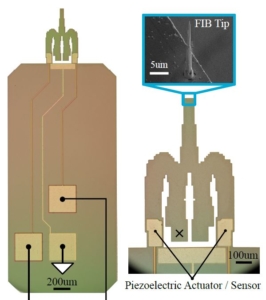 | S. I. Moore; M. G. Ruppert; Y. K. Yong AFM Cantilever Design for Multimode Q Control: Arbitrary Placement of Higher-Order Modes Journal Article In: IEEE/ASME Transactions on Mechatronics, pp. 1-6, 2020, (This work was supported by the Australian Research Council Discovery Project DP170101813). Abstract | Links | BibTeX | Tags: AFM, Cantilever, DP170101813, MEMS, Multifrequency AFM, Smart Structures, SPM, Vibration Control @article{Moore2020,In the fast growing field of multifrequency atomic force microscopy (AFM), the benefits of using higher-order modes has been extensively reported on. However, higher modes of AFM cantilevers are difficult to instrument and Q control is challenging owing to their high frequency nature. At these high frequencies, the latencies in the computations and analog conversions of digital signal processing platforms become significant and limit the effective bandwidth of digital feedback controller implementations. To address this issue, this article presents a novel cantilever design for which the first five modes are placed within a 200 kHz bandwidth. The proposed cantilever is designed using a structural optimization routine. The close spacing and low mechanical bandwidth of the resulting cantilever allows for the implementation of Q controllers for all five modes using a standard FPGA development board for bimodal AFM and imaging on higher-order modes. |
| 21. | 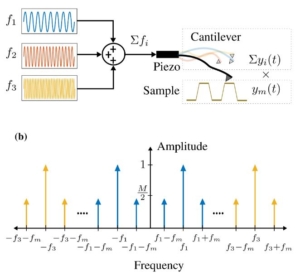 | D. M. Harcombe; M. G. Ruppert; A. J. Fleming A review of demodulation techniques for multifrequency atomic force microscopy Journal Article In: Beilstein Journal of Nanotechnology, vol. 11, pp. 76-97, 2020, ISSN: 21904286. Abstract | Links | BibTeX | Tags: AFM, Demodulation, Multifrequency AFM, SPM @article{Harcombe2020,This article compares the performance of traditional and recently proposed demodulators for multifrequency atomic force microscopy. The compared methods include the lock-in amplifier, coherent demodulator, Kalman filter, Lyapunov filter, and direct-design demodulator. Each method is implemented on a field-programmable gate array (FPGA) with a sampling rate of 1.5 MHz. The metrics for comparison include the sensitivity to other frequency components and the magnitude of demodulation artifacts for a range of demodulator bandwidths. Performance differences are demonstrated through higher harmonic atomic force microscopy imaging. |
2019 |
||
| 20. | 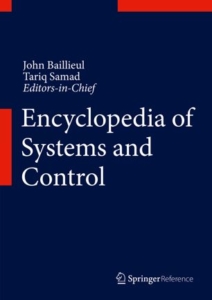 | M. G. Ruppert; S. O. R. Moheimani Dynamics and Control of Active Microcantilevers Book Chapter In: Baillieul, John; Samad, Tariq (Ed.): Encyclopedia of Systems and Control, vol. 2, Springer London, 2019, ISBN: 978-1-4471-5102-9. Abstract | Links | BibTeX | Tags: AFM, Cantilever, MEMS, Multifrequency AFM, Piezoelectric Transducers and Drives, Smart Structures, Vibration Control @inbook{Ruppert2019b,The microcantilever is a key precision mechatronic component of many technologies for characterization and manipulation of matter at the nanoscale, particularly in the atomic force microscope. When a cantilever is operated in a regime that requires the direct excitation and measurement of its resonance frequencies, appropriate instrumentation and control is crucial for high-performance operation. In this entry, we discuss integrated cantilever actuation and present the cantilever transfer function model and its properties. As a result of using these active cantilevers, the ability to control the quality factor in order to manipulate the cantilever tracking bandwidth is demonstrated. |
| 19. | 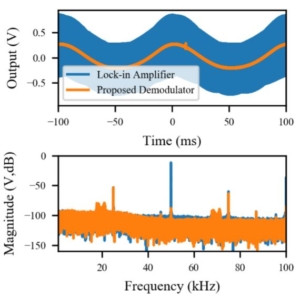 | S. I. Moore; M. G. Ruppert; D. M. Harcombe; A. J. Fleming; Y. K. Yong Design and Analysis of Low-Distortion Demodulators for Modulated Sensors Journal Article In: IEEE/ASME Transactions on Mechatronics, vol. 24, no. 4, pp. 1861-1870, 2019, ISSN: 10834435, (This work was supported by the Australian Research Council Discovery Project DP170101813). Abstract | Links | BibTeX | Tags: Demodulation, DP170101813, Multifrequency AFM, Nanopositioning, SPM @article{Moore2019,System-based demodulators in the form of a Kalman and Lyapunov filter have been demonstrated to significantly outperform traditional demodulators, such as the lock-in amplifier, in bandwidth sensitive applications, for example high-speed atomic force microscopy. Building on their closed loop architecture, this article describes a broader class of high-speed closed-loop demodulators. The generic structure provides greater flexibility to independently control the bandwidth and sensitivity to out-of-band frequencies. A linear time-invariant description is derived which allows the utilization of linear control theory to design the demodulator. Experimental results on a nanopositioner with capacitive sensors demonstrate the realization of arbitrary demodulator dynamics while achieving excellent noise rejection. |
| 18. | 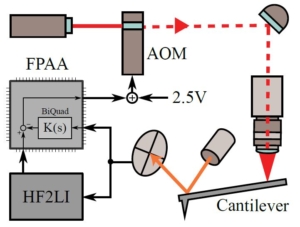 | M. G. Ruppert; B. S. Routley; A. J. Fleming; Y. K. Yong; G. E. Fantner Model-based Q Factor Control for Photothermally Excited Microcantilevers Proceedings Article In: Int. Conference on Manipulation, Automation and Robotics at Small Scales (MARSS), Helsinki, Finland, 2019, ISSN: 978-1-7281-0948-0, (This work was supported by the Australian Research Council Discovery Project DP170101813). Abstract | Links | BibTeX | Tags: AFM, DP170101813, Multifrequency AFM, Sensors, Smart Structures, SPM, Vibration Control @inproceedings{Ruppert2019,Photothermal excitation of the cantilever for dynamic atomic force microscopy (AFM) modes is an attractive actuation method as it provides clean cantilever actuation leading to well-defined frequency responses. Unlike conventional piezo-acoustic excitation of the cantilever, it allows for model-based quality (Q) factor control in order to increase the cantilever tracking bandwidth for tapping-mode AFM or to reduce resonant ringing for high-speed photothermal offresonance tapping (PORT) in ambient conditions. In this work, we present system identification, controller design and experimental results on controlling the Q factor of a photothermally driven cantilever. The work is expected to lay the groundwork for future implementations for high-speed PORT imaging in ambient conditions. |
| 17. | 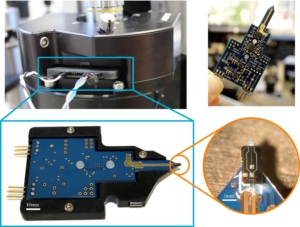 | M. G. Ruppert; S. I. Moore; M. Zawierta; A. J. Fleming; G. Putrino; Y. K. Yong Multimodal atomic force microscopy with optimized higher eigenmode sensitivity using on-chip piezoelectric actuation and sensing Journal Article In: Nanotechnology, vol. 30, no. 8, pp. 085503, 2019, (This work was supported by the Australian Research Council Discovery Project DP170101813). Abstract | Links | BibTeX | Tags: AFM, Cantilever, DP170101813, MEMS, Multifrequency AFM, Piezoelectric Transducers and Drives, Sensors, Smart Structures, SPM @article{Ruppert2018b,Atomic force microscope (AFM) cantilevers with integrated actuation and sensing provide several distinct advantages over conventional cantilever instrumentation. These include clean frequency responses, the possibility of down-scaling and parallelization to cantilever arrays as well as the absence of optical interference. While cantilever microfabrication technology has continuously advanced over the years, the overall design has remained largely unchanged; a passive rectangular shaped cantilever design has been adopted as the industry wide standard. In this article, we demonstrate multimode AFM imaging on higher eigenmodes as well as bimodal AFM imaging with cantilevers using fully integrated piezoelectric actuation and sensing. The cantilever design maximizes the higher eigenmode deflection sensitivity by optimizing the transducer layout according to the strain mode shape. Without the need for feedthrough cancellation, the read-out method achieves close to zero actuator/sensor feedthrough and the sensitivity is sufficient to resolve the cantilever Brownian motion. |
2018 |
||
| 16. |  | S. I. Moore; M. G. Ruppert; Y. K. Yong Arbitrary placement of AFM cantilever higher eigenmodes using structural optimization Proceedings Article In: International Conference on Manipulation, Automation and Robotics at Small Scales (MARSS), 2018, (This work was supported by the Australian Research Council Discovery Project DP170101813). Abstract | BibTeX | Tags: AFM, Cantilever, DP170101813, MEMS, Multifrequency AFM, Piezoelectric Transducers and Drives, Sensors, SPM, System Identification @inproceedings{Moore2018,This article presents a novel cantilever design approach to place higher mode frequencies within a specific frequency band to alleviate instrumentation and Q control feasibility. This work is motivated by the emerging field of multifrequency atomic force microscopy (AFM) which involves the excitation and/or detection of several cantilever modes at once. Unlike other operating modes, multifrequency AFM allows the tracking of the sample topography on the fundamental mode while simultaneously acquiring complimentary nanomechanical information on a higher mode. However, higher modes of conventional rectangular tapping-mode cantilevers are usually in the MHz regime and therefore impose severe restrictions on the direct controllability of these modes. To overcome this limitation, an optimization technique is employed which is capable of placing the first five modes within a 200 kHz bandwidth. |
| 15. |  | M. G. Ruppert Self-sensing, estimation and control in multifrequency Atomic Force Microscopy. Journal Article In: Journal & Proceedings of the Royal Society of New South Wales, vol. 151, no. 1, pp. 111, 2018, ISSN: 0035-9173/18/010111-01. Abstract | Links | BibTeX | Tags: Cantilever, MEMS, Multifrequency AFM, Sensors, Smart Structures, SPM, System Identification, Vibration Control @article{Ruppert2018b,Despite the undeniable success of the atomic force microscope (AFM), dynamic techniques still face limitations in terms of spatial resolution, imaging speed and high cost of acquisition. In order to expand the capabilities of the instrument, it was realized that the information about the nano-mechanical properties of a sample are encoded over a range of frequencies and the excitation and detection of higher-order eigenmodes of the micro-cantilever open up further informa- tion channels. The ability to control these modes and their fast responses to excitation is believed to be the key to unravelling the true potential of these ethods. This work addresses three major drawbacks of the standard AFM setup, which limit the feasibility of multi-frequency approaches. First, microelectromechanical system (MEMS) probes with integrated piezoelectric layers is motivated, enabling the development of novel multimode self-sensing and self-actuating techniques. Specifically, these piezoelectric transduction schemes permit the miniaturization of the entire AFM towards a cost-effective single-chip device with nanoscale precision in a much smaller form factor than that of conventional macroscale instruments. Second, the integrated actuation enables the development of multimode controllers which exhibits remarkable performance in arbitrarily modifying the quality factor of multiple eigenmodes and comes with inherent stability robustness. The experimental results demonstrate improved imaging stability, higher scan speeds and adjustable contrast when mapping nano-mechanical properties of soft samples. Last, in light of the demand for constantly increasing imaging speeds while providing multi-frequency flexibility, the estimation of multiple components of the high-frequency deflection signal is performed with a linear time-varying multi-frequency Kalman filter. The chosen representation allows for an efficient high-bandwidth implementation on a Field Programmable Gate Array. Tracking bandwidth, noise performance and trimodal AFM imaging on a two-component polymer sample are verified and shown to be superior to that of the commonly used lock-in amplifier. |
| 14. | 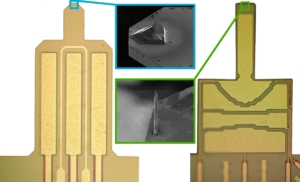 | M. G. Ruppert; S. I. Moore; M. Zawierta; G. Putrino; Y. K. Yong Advanced Sensing and Control with Active Cantilevers for Multimodal Atomic Force Microscopy Conference 7th Multifrequency AFM Conference, Madrid, Spain, 2018, (This work was supported by the Australian Research Council Discovery Project DP170101813). Abstract | BibTeX | Tags: AFM, Cantilever, DP170101813, MEMS, Multifrequency AFM, Sensors, Smart Structures, SPM, Vibration Control @conference{Ruppert2018,Atomic force microscopy (AFM) cantilevers with integrated actuation and sensing on the chip level provide several distinct advantages over conventional cantilever instrumentation. These include clean frequency responses, the possibility of down-scaling and parallelization to cantilever arrays as well as the absence of optical interferences. While cantilever microfabrication technology has continuously advanced over the years, the overall design has remained largely unchanged; a passive rectangular shaped cantilever design has been adopted as the industry wide standard. Consequently, conventional cantilever instrumentation requires external piezo acoustic excitation as well as an external optical deflection sensor. Both of these components are not optimal for current trends in multifrequency AFM technology which revolve around further down-sizing, parallelization and measurements at multiple higher eigenmodes. Using microelectromechanical systems (MEMS) fabrication processes, this work aims to optimize cantilever instrumentation by realizing a new class of probes with high-performance integrated actuators and sensors. Equipped with multiple integrated piezoelectric layers for both actuation and sensing, these cantilevers are capable of achieving an increased higher eigenmode sensitivity and/or guaranteed collocated system properties compared to commercially available counterparts; examples of such designs are shown in Figure 1. The geometry as well as the integrated actuator/sensor arrangement is optimized using finite element modelling with individual design goals. The designs are realized using a commercial MEMS fabrication process and only require a simple five-mask patterning and etching process and post-fabricated sharp tips. |
| 13. | 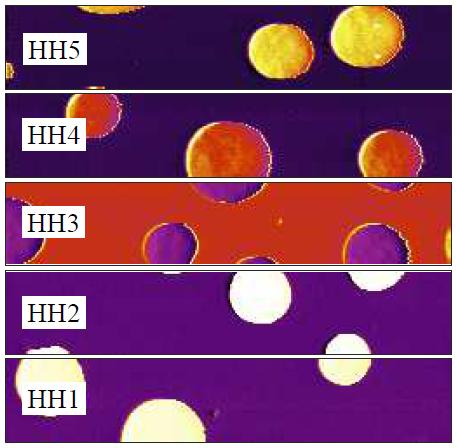 | D. M. Harcombe; M. G. Ruppert; M. R. P. Ragazzon; A. J. Fleming Lyapunov Estimation for High-Speed Demodulation in Multifrequency Atomic Force Microscopy Journal Article In: Beilstein Journal of Nanotechnology, vol. 9, pp. 490-498, 2018, ISSN: 21904286. Abstract | Links | BibTeX | Tags: AFM, Multifrequency AFM @article{J18c,An important issue in the emerging field of multifrequency atomic force microscopy (MF-AFM) is the accurate and fast demodulation of the cantilever-tip deflection signal. As this signal consists of multiple frequency components and noise processes, a lock-in amplifier is typically employed for its narrowband response. However, this demodulator suffers inherent bandwidth limitations as high frequency mixing products must be filtered out and several must be operated in parallel. Many MF-AFM methods require amplitude and phase demodulation at multiple frequencies of interest, enabling both z-axis feedback and phase contrast imaging to be achieved. This article proposes a model-based multifrequency Lyapunov filter implemented on a Field Programmable Gate Array (FPGA) for high-speed MF-AFM demodulation. System descriptions and simulations are verified by experimental results demonstrating high tracking bandwidths, strong off-mode rejection and minor sensitivity to cross-coupling effects. Additionally, a five-frequency system operating at 3.5MHz is implemented for higher harmonic amplitude and phase imaging up to 1MHz. |
2017 |
||
| 12. | 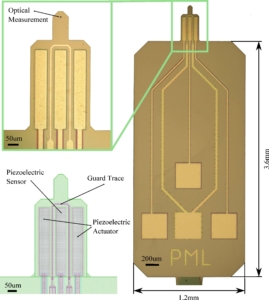 | M. G. Ruppert; Y. K. Yong Note: Guaranteed collocated multimode control of an atomic force microscope cantilever using on-chip piezoelectric actuation and sensing Journal Article In: Review of Scientific Instruments, vol. 88, no. 086109, 2017, (This work was supported by the Australian Research Council Discovery Project DP170101813). Abstract | Links | BibTeX | Tags: AFM, Cantilever, DP170101813, MEMS, Multifrequency AFM, Piezoelectric Transducers and Drives, System Identification, Vibration Control @article{Ruppert2017b,The quality (Q) factor is an important parameter of the resonance of the microcantilever as it determines both imaging bandwidth and force sensitivity. The ability to control the Q factor of multiple modes is believed to be of great benefit for atomic force microscopy techniques involving multiple eigenmodes. In this paper, we propose a novel cantilever design employing multiple piezoelectric transducers which are used for separated actuation and sensing, leading to guaranteed collocation of the first eight eigenmodes up to 3 MHz. The design minimizes the feedthrough usually observed with these systems by incorporating a guard trace on the cantilever chip. As a result, a multimode Q controller is demonstrated to be able to modify the quality factor of the first two eigenmodes over up to four orders of magnitude without sacrificing robust stability. |
| 11. | 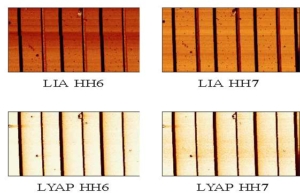 | D. M. Harcombe; M. G. Ruppert; A. J. Fleming Higher-harmonic AFM Imaging with a High-Bandwidth Multifrequency Lyapunov Filter Proceedings Article In: IEEE/ASME Advanced Intelligent Mechatronics (AIM), Munich, Germany, 2017. Abstract | BibTeX | Tags: Multifrequency AFM, SPM @inproceedings{C17e,A major difficulty in multifrequency atomic force microscopy (MF-AFM) is the accurate estimation of amplitude and phase at multiple frequencies for both z-axis feedback and material contrast imaging. Typically a lock-in amplifier is chosen as it is both narrowband and simple to implement. However, it inherently suffers drawbacks including a limited bandwidth due to post mixing low-pass filters and the necessity for multiple to be operated in parallel for MF-AFM. This paper proposes a multifrequency demodulator in the form of a modelbased Lyapunov filter implemented on a Field Programmable Gate Array (FPGA). System modelling and simulations are verified by experimental results demonstrating high tracking bandwidth and off-mode rejection at modelled frequencies. Additionally, AFM scans with a five-frequency-based system are presented wherein higher harmonic imaging is performed up to 1 MHz. |
| 10. | 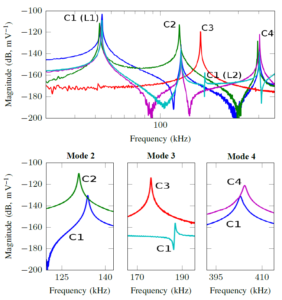 | S. I. Moore; M. G. Ruppert; Y. K. Yong Design and Analysis of Piezoelectric Cantilevers with Enhanced Higher Eigenmodes for Atomic Force Microscopy Proceedings Article In: IEEE/ASME Advanced Intelligent Mechatronics (AIM), Munich, Germany, 2017, (This work was supported by the Australian Research Council Discovery Project DP170101813). Abstract | BibTeX | Tags: DP170101813, Multifrequency AFM, SPM @inproceedings{Moore2017b,Atomic force microscope (AFM) cantilevers with integrated actuation and sensing provide several distinct advantages over conventional cantilever instrumentation such as clean frequency responses, the possibility of down-scaling and parallelization to cantilever arrays as well as the absence of optical interferences. However, for multifrequency AFM techniques involving higher eigenmodes of the cantilever, optimization of the transducer location and layout has to be taken into account. This work proposes multiple integrated piezoelectric regions on the cantilever which maximize the deflection of the cantilever and the piezoelectric charge response for a given higher eigenmode based on the spatial strain distribution. Finite element analysis is performed to find the optimal transducer topology and experimental results are presented which highlight an actuation gain improvement up to 42 dB on the third mode and sensor sensitivity improvement up to 38 dB on the second mode. |
| 9. | 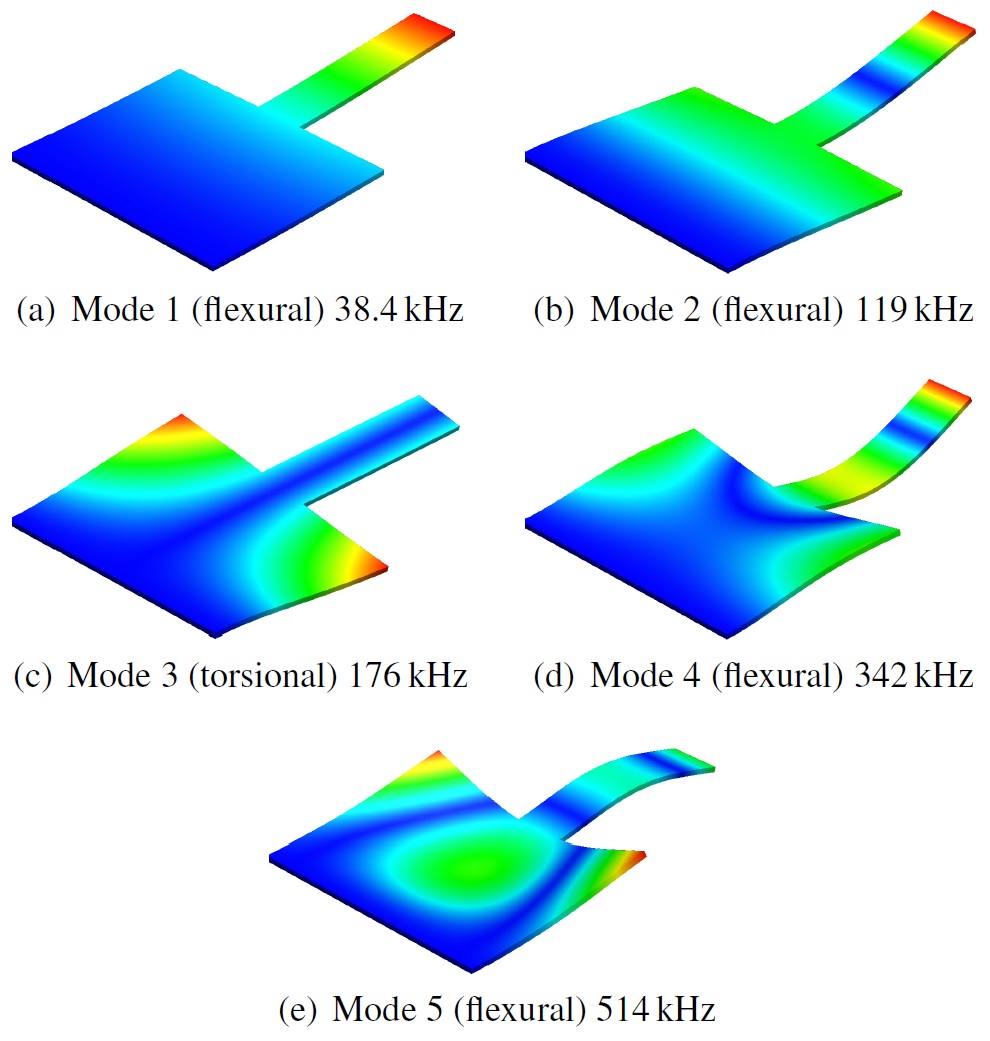 | S. I. Moore; Y. K. Yong Design and Characterization of Cantilevers for Multi-Frequency Atomic Force Microscopy Journal Article In: Micro & Nano Letters, vol. 12, no. 5, pp. 315-320, 2017, (This work was supported by the Australian Research Council Discovery Project DP170101813). Abstract | Links | BibTeX | Tags: Cantilever, DP170101813, MEMS, Multifrequency AFM, SPM @article{Moore2017,The experimental characterisation of a set of microcantilevers targeted at use in multi-frequency atomic force microscope is presented. The aim of this work is to design a cantilever that naturally amplifies its harmonic oscillations which are introduced by nonlinear probe–sample interaction forces. This is performed by placing the modal frequencies of the cantilever at integer multiples of the first modal frequency. The developed routine demonstrates the placement of the frequency of the second to fifth mode. The characterisation shows a trend that lower-order modes are more accurately placed than higher-order modes. With two fabricated designs, the error in the second mode is at most 2.26% while the greatest error in the fifth mode is at 10.5%. |
| 8. | 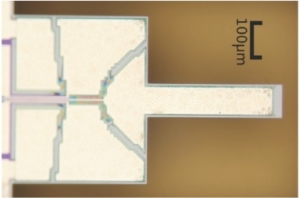 | S. I. Moore; M. G. Ruppert; Y. K. Yong Multimodal cantilevers with novel piezoelectric layer topology for sensitivity enhancement Journal Article In: Beilstein Journal of Nanotechnology, vol. 8, pp. 358–371, 2017, (This work was supported by the Australian Research Council Discovery Project DP170101813). Abstract | Links | BibTeX | Tags: Cantilever, DP170101813, Multifrequency AFM, Piezoelectric Transducers and Drives, SPM @article{Moore2017b,Self-sensing techniques for atomic force microscope (AFM) cantilevers have several advantageous characteristics compared to the optical beam deflection method. The possibility of down scaling, parallelization of cantilever arrays and the absence of optical interference associated imaging artifacts have led to an increased research interest in these methods. However, for multifrequency AFM, the optimization of the transducer layout on the cantilever for higher order modes has not been addressed. To fully utilize an integrated piezoelectric transducer, this work alters the layout of the piezoelectric layer to maximize both the deflection of the cantilever and measured piezoelectric charge response for a given mode with respect to the spatial distribution of the strain. On a prototype cantilever design, significant increases in actuator and sensor sensitivities were achieved for the first four modes without any substantial increase in sensor noise. The transduction mechanism is specifically targeted at multifrequency AFM and has the potential to provide higher resolution imaging on higher order modes. |
2016 |
||
| 7. | 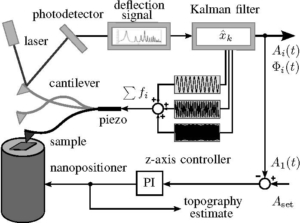 | M. G. Ruppert; D. M. Harcombe; S. O. R. Moheimani High-Bandwidth Demodulation in MF-AFM: A Kalman Filtering Approach Journal Article In: IEEE/ASME Transactions on Mechatronics, vol. 21, no. 6, pp. 2705-2715, 2016. Abstract | Links | BibTeX | Tags: Multifrequency AFM, SPM @article{Ruppert2016,Emerging multifrequency atomic force microscopy (MF-AFM) methods rely on coherent demodulation of the cantilever deflection signal at multiple frequencies. These measurements are needed in order to close the z-axis feedback loop and to acquire complementary information on the tip-sample interaction. While the common method is to use a lock-in amplifier capable of recovering low-level signals from noisy backgrounds, its performance is ultimately bounded by the bandwidth of the low-pass filters. In light of the demand for constantly increasing imaging speeds while providing multifrequency flexibility, we propose to estimate the in-phase and quadrature components with a linear time-varying Kalman filter. The chosen representation allows for an efficient high-bandwidth implementation on a Field Programmable Gate Array (FPGA). Tracking bandwidth and noise performance are verified experimentally and trimodal AFM results on a two-component polymer sample highlight the applicability of the proposed method for MF-AFM. |
| 6. | 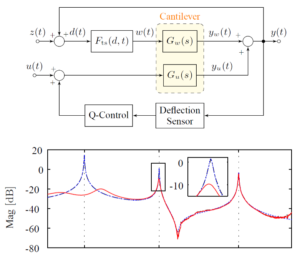 | M. G. Ruppert; S. O. R. Moheimani Multimode Q Control in Tapping-Mode AFM: Enabling Imaging on Higher Flexural Eigenmodes Journal Article In: IEEE Transactions on Control Systems Technology, vol. 24, no. 4, pp. 1149-1159, 2016. Abstract | Links | BibTeX | Tags: MEMS, Multifrequency AFM, SPM, System Identification, Vibration Control @article{Ruppert2016b,Numerous dynamic Atomic Force Microscopy (AFM) methods have appeared in recent years, which make use of the excitation and detection of higher order eigenmodes of the microcantilever. The ability to control these modes and their responses to excitation is believed to be the key to unraveling the true potential of these methods. In this work, we highlight a multi-mode Q control method that exhibits remarkable damping performance and stability robustness. The experimental results obtained in ambient conditions demonstrate improved imaging stability by damping non-driven resonant modes when scanning is performed at a higher eigenmode of the cantilever. Higher scan speeds are shown to result from a decrease in transient response time. |
| 5. | 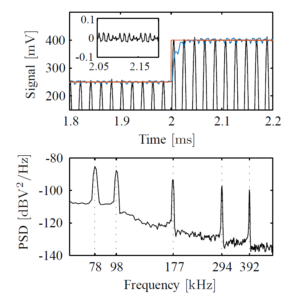 | M. G. Ruppert; D. M. Harcombe; S. O. R. Moheimani State estimation for high-speed multifrequency atomic force microscopy Proceedings Article In: American Control Conference, pp. 2617-2622, Boston, MA, USA, 2016. Abstract | Links | BibTeX | Tags: Multifrequency AFM, SPM @inproceedings{Ruppert2016b,A fundamental component in the z-axis feedback loop of an atomic force microscope (AFM) operated in dynamic mode is the lock-in amplifier to obtain amplitude and phase of the high-frequency cantilever deflection signal. While this narrowband demodulation technique is capable of filtering noise far away from the carrier and modulation frequency, its performance is ultimately bounded by the bandwidth of its low-pass filter which is employed to suppress the frequency component at twice the carrier frequency. Moreover, multiple eigenmodes and higher harmonics are used for imaging in modern multifrequency AFMs, which necessitates multiple lock-in amplifiers to recover the respective amplitude and phase information. We propose to estimate amplitude and phase of multiple frequency components with a linear time-varying Kalman filter which allows for an efficient implementation on a Field Programmable Gate Array (FPGA). While experimental results for the single mode case have already proven to increase the imaging bandwidth in tapping-mode AFM, multifrequency simulations promise further improvement in imaging flexibility. |
| 4. | 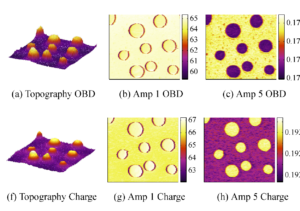 | M. G. Ruppert; S. O. R. Moheimani High-bandwidth Multimode Self-sensing in Bimodal Atomic Force Microscopy Journal Article In: Beilstein Journal of Nanotechnology, vol. 7, pp. 284-295, 2016. Abstract | Links | BibTeX | Tags: MEMS, Multifrequency AFM, Piezoelectric Transducers and Drives, Vibration Control @article{Ruppert2016b,Using standard microelectromechanical system (MEMS) processes to coat a microcantilever with a piezoelectric layer results in a versatile transducer with inherent self-sensing capabilities. For applications in multifrequency atomic force microscopy (MF-AFM), we illustrate that a single piezoelectric layer can be simultaneously used for multimode excitation and detection of the cantilever deflection. This is achieved by a charge sensor with a bandwidth of 10 MHz and dual feedthrough cancellation to recover the resonant modes that are heavily buried in feedthrough originating from the piezoelectric capacitance. The setup enables the omission of the commonly used piezoelectric stack actuator and optical beam deflection sensor, alleviating limitations due to distorted frequency responses and instrumentation cost, respectively. The proposed method benefits from a more than two orders of magnitude increase in deflection to strain sensitivity on the fifth eigenmode leading to a remarkable signal-to-noise ratio. Experimental results using bimodal AFM imaging on a two component polymer sample validate that the self-sensing scheme can therefore be used to provide both the feedback signal, for topography imaging on the fundamental mode, and phase imaging on the higher eigenmode. |
| 3. | 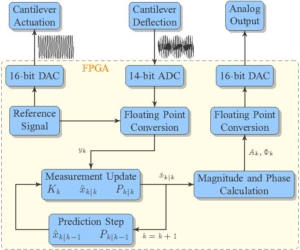 | M. G. Ruppert; K. S. Karvinen; S. L. Wiggins; S. O. R. Moheimani A Kalman Filter for Amplitude Estimation in High-Speed Dynamic Mode Atomic Force Microscopy Journal Article In: IEEE Transactions on Control Systems Technology, vol. 24, no. 1, pp. 276-284, 2016. Abstract | Links | BibTeX | Tags: Multifrequency AFM, SPM, Vibration Control @article{Ruppert2016b,A fundamental challenge in dynamic mode atomic force microscopy (AFM) is the estimation of the cantilever oscillation amplitude from the deflection signal which might be distorted by noise and/or high-frequency components. When the cantilever is excited at resonance, its deflection is typically obtained via narrowband demodulation using a lock-in amplifier. However, the bandwidth of this measurement technique is ultimately bounded by the low-pass filter which must be employed after demodulation to attenuate the component at twice the carrier frequency. Furthermore, to measure the amplitude of multiple frequency components such as higher eigenmodes and/or higher harmonics in multifrequency AFM, multiple lock-in amplifiers must be employed. In this work, the authors propose the estimation of amplitude and phase using a linear time-varying Kalman filter which is easily extended to multiple frequencies. Experimental results are obtained using square-modulated sine waves and closed-loop AFM scans, verifying the performance of the proposed Kalman filter. |
2015 |
||
| 2. | 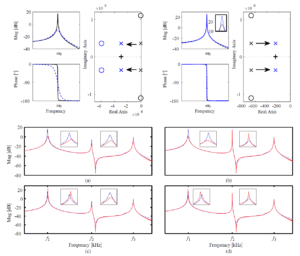 | M. G. Ruppert; S. O. R. Moheimani Multi-Mode Q Control in Multifrequency Atomic Force Microscopy Proceedings Article In: ASME International Design Engineering Technical Conferences & Computers and Information in Engineering Conference, pp. V004T09A009, Boston, Massachusetts, USA, 2015. Abstract | Links | BibTeX | Tags: MEMS, Multifrequency AFM, SPM, Vibration Control @inproceedings{Ruppert2015,Various Atomic Force Microscopy (AFM) modes have emerged which rely on the excitation and detection of multiple eigenmodes of the microcantilever. The conventional control loops employed in multifrequency AFM (MF-AFM) such as bimodal imaging where the fundamental mode is used to map the topography and a higher eigenmode is used to map sample material properties only focus on maintaining low bandwidth signals such as amplitude and/ or frequency shift. However, the ability to perform additional high bandwidth control of the quality (Q) factor of the participating modes is believed to be imperative to unfolding the full potential of these methods. This can be achieved by employing a multi-mode Q control approach utilizing positive position feedback. The controller exhibits remarkable performance in arbitrarily modifying the Q factor of multiple eigenmodes as well as guaranteed stability properties when used on flexible structures with collocated actuators and sensors. A controller design method based on pole placement optimization is proposed for setting an arbitrary on-resonance Q factor of the participating eigenmodes. Experimental results using bimodal AFM imaging on a two component polymer sample are presented. |
2013 |
||
| 1. | 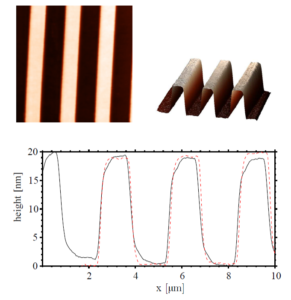 | M. G. Ruppert; M. Fairbairn; S. O. R. Moheimani Multi-Mode Resonant Control of a Microcantilever for Atomic Force Microscopy Proceedings Article In: IEEE/ASME International Conference on Advanced Intelligent Mechatronics, pp. 77-82, Wollongong, Australia, 2013. Abstract | Links | BibTeX | Tags: MEMS, Multifrequency AFM, Vibration Control @inproceedings{Ruppert2013,When operating the Atomic Force Microscope in tapping mode it is possible to decrease the quality factor of the microcantilever to enhance scan speed. %Standard Q Control techniques involve velocity feedback with the disadvantage of additional sensor equipment, or time-delay position feedback which may lead to instabilities of out-of-bandwidth modes.Various resonance controllers have been proposed which do not rely on expensive velocity sensors and guarantee stability of the closed loop system even in the presence of unmodeled dynamics. A new field of Atomic Force Microscopy is evolving, which makes use of multiple frequency excitation and detection of the cantilever modes making it necessary to be able to control these modes and their response to excitation. This work proposes a multi-mode Q control approach utilizing positive position feedback, offering full control over the first two flexural modes of the cantilever. By completely damping the first mode and adjusting the quality factor of the second mode, it is possible to scan and obtain images at the second resonance frequency which improves image quality at high scan speeds due to the increased bandwidth of the z-axis feedback loop. |
2022 |
||
| 25. |  | Experimental Analysis of Tip Vibrations at Higher Eigenmodes of QPlus Sensors for Atomic Force Microscopy Journal Article In: Nanotechnology, vol. 33, iss. 18, pp. 185503, 2022, ISSN: 1361-6528, (This work was supported in part by the Australian Research Council Discovery Project DP170101813). |
2020 |
||
| 24. |  | Overcoming the Limitations of Tip Enhanced Raman Spectroscopy with Intermittent Contact AFM Conference 8th Multifrequency AFM Conference, Madrid, Spain, 2020. |
| 23. |  | Traditional and Novel Demodulators for Multifrequency Atomic Force Microscopy Conference 8th Multifrequency AFM Conference, Madrid, Spain, 2020. |
| 22. |  | AFM Cantilever Design for Multimode Q Control: Arbitrary Placement of Higher-Order Modes Journal Article In: IEEE/ASME Transactions on Mechatronics, pp. 1-6, 2020, (This work was supported by the Australian Research Council Discovery Project DP170101813). |
| 21. |  | A review of demodulation techniques for multifrequency atomic force microscopy Journal Article In: Beilstein Journal of Nanotechnology, vol. 11, pp. 76-97, 2020, ISSN: 21904286. |
2019 |
||
| 20. |  | Dynamics and Control of Active Microcantilevers Book Chapter In: Baillieul, John; Samad, Tariq (Ed.): Encyclopedia of Systems and Control, vol. 2, Springer London, 2019, ISBN: 978-1-4471-5102-9. |
| 19. |  | Design and Analysis of Low-Distortion Demodulators for Modulated Sensors Journal Article In: IEEE/ASME Transactions on Mechatronics, vol. 24, no. 4, pp. 1861-1870, 2019, ISSN: 10834435, (This work was supported by the Australian Research Council Discovery Project DP170101813). |
| 18. |  | Model-based Q Factor Control for Photothermally Excited Microcantilevers Proceedings Article In: Int. Conference on Manipulation, Automation and Robotics at Small Scales (MARSS), Helsinki, Finland, 2019, ISSN: 978-1-7281-0948-0, (This work was supported by the Australian Research Council Discovery Project DP170101813). |
| 17. |  | Multimodal atomic force microscopy with optimized higher eigenmode sensitivity using on-chip piezoelectric actuation and sensing Journal Article In: Nanotechnology, vol. 30, no. 8, pp. 085503, 2019, (This work was supported by the Australian Research Council Discovery Project DP170101813). |
2018 |
||
| 16. |  | Arbitrary placement of AFM cantilever higher eigenmodes using structural optimization Proceedings Article In: International Conference on Manipulation, Automation and Robotics at Small Scales (MARSS), 2018, (This work was supported by the Australian Research Council Discovery Project DP170101813). |
| 15. |  | Self-sensing, estimation and control in multifrequency Atomic Force Microscopy. Journal Article In: Journal & Proceedings of the Royal Society of New South Wales, vol. 151, no. 1, pp. 111, 2018, ISSN: 0035-9173/18/010111-01. |
| 14. |  | Advanced Sensing and Control with Active Cantilevers for Multimodal Atomic Force Microscopy Conference 7th Multifrequency AFM Conference, Madrid, Spain, 2018, (This work was supported by the Australian Research Council Discovery Project DP170101813). |
| 13. |  | Lyapunov Estimation for High-Speed Demodulation in Multifrequency Atomic Force Microscopy Journal Article In: Beilstein Journal of Nanotechnology, vol. 9, pp. 490-498, 2018, ISSN: 21904286. |
2017 |
||
| 12. |  | Note: Guaranteed collocated multimode control of an atomic force microscope cantilever using on-chip piezoelectric actuation and sensing Journal Article In: Review of Scientific Instruments, vol. 88, no. 086109, 2017, (This work was supported by the Australian Research Council Discovery Project DP170101813). |
| 11. |  | Higher-harmonic AFM Imaging with a High-Bandwidth Multifrequency Lyapunov Filter Proceedings Article In: IEEE/ASME Advanced Intelligent Mechatronics (AIM), Munich, Germany, 2017. |
| 10. |  | Design and Analysis of Piezoelectric Cantilevers with Enhanced Higher Eigenmodes for Atomic Force Microscopy Proceedings Article In: IEEE/ASME Advanced Intelligent Mechatronics (AIM), Munich, Germany, 2017, (This work was supported by the Australian Research Council Discovery Project DP170101813). |
| 9. |  | Design and Characterization of Cantilevers for Multi-Frequency Atomic Force Microscopy Journal Article In: Micro & Nano Letters, vol. 12, no. 5, pp. 315-320, 2017, (This work was supported by the Australian Research Council Discovery Project DP170101813). |
| 8. |  | Multimodal cantilevers with novel piezoelectric layer topology for sensitivity enhancement Journal Article In: Beilstein Journal of Nanotechnology, vol. 8, pp. 358–371, 2017, (This work was supported by the Australian Research Council Discovery Project DP170101813). |
2016 |
||
| 7. |  | High-Bandwidth Demodulation in MF-AFM: A Kalman Filtering Approach Journal Article In: IEEE/ASME Transactions on Mechatronics, vol. 21, no. 6, pp. 2705-2715, 2016. |
| 6. |  | Multimode Q Control in Tapping-Mode AFM: Enabling Imaging on Higher Flexural Eigenmodes Journal Article In: IEEE Transactions on Control Systems Technology, vol. 24, no. 4, pp. 1149-1159, 2016. |
| 5. |  | State estimation for high-speed multifrequency atomic force microscopy Proceedings Article In: American Control Conference, pp. 2617-2622, Boston, MA, USA, 2016. |
| 4. |  | High-bandwidth Multimode Self-sensing in Bimodal Atomic Force Microscopy Journal Article In: Beilstein Journal of Nanotechnology, vol. 7, pp. 284-295, 2016. |
| 3. |  | A Kalman Filter for Amplitude Estimation in High-Speed Dynamic Mode Atomic Force Microscopy Journal Article In: IEEE Transactions on Control Systems Technology, vol. 24, no. 1, pp. 276-284, 2016. |
2015 |
||
| 2. |  | Multi-Mode Q Control in Multifrequency Atomic Force Microscopy Proceedings Article In: ASME International Design Engineering Technical Conferences & Computers and Information in Engineering Conference, pp. V004T09A009, Boston, Massachusetts, USA, 2015. |
2013 |
||
| 1. |  | Multi-Mode Resonant Control of a Microcantilever for Atomic Force Microscopy Proceedings Article In: IEEE/ASME International Conference on Advanced Intelligent Mechatronics, pp. 77-82, Wollongong, Australia, 2013. |
